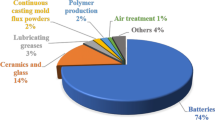Abstract
A chromatographic method for separation of strontium from rubidium, using the unique alkaline-earth metal complexation ability of the carboxylic acids EDTA and DCTA is proposed. The method was developed in order to improve the effectiveness of 87Sr/86Sr isotope studies with ICP–QMS. Due to the isobaric overlap of 87Rb with 87Sr, strontium needs to be separated from rubidium prior to sample analysis with ICP–QMS. The method involves the retention of strontium, calcium, magnesium, and rubidium on Dowex 50W-X8 resin in its NH4 + form, followed by elution of the divalent cations as metal EDTA or DCTA complexes. Because divalent cations have different EDTA and DCTA complex formation constants, it is possible to separate them under the correct conditions. Neither EDTA nor DCTA form complexes with alkali metals, thus rubidium remains retained by the column and is later eluted using HNO3. Both EDTA and DCTA elution methods were tested with different concentrations of the elements to determine the effect of increased concentration on separation efficiency. The EDTA elution procedure was proved to be effective in separating strontium from both calcium and rubidium, while the DCTA method was found to be even more effective, because strontium is separated from all the elements involved in this study.










Similar content being viewed by others
References
Almeida CMR, Vasconcelos MTSD (2001) J Anal At Spectrom 16:607–611
Almeida CMR, Vasconcelos MTSD (2004) Food Chem 85:7–12
Horn P, Schaaf P, Holbach B, Holzl S, Eschenauer H (1993) Z Lebensm Unters Forsch 196:407–409
Barbaste M, Robinson K, Guilfoyle S, Medina B, Lobinski R (2002) J Anal At Spectrom 2:135–137
Kawasaki A, Oda HW, Hirata T (2002) Soil Sci Plant Nutr 48:635–640
Dufour E, Holmden C, Van Neer W, Zazzo A, Patterson WP, Degryse P, Keppens E (2006) J Archeol Sci 2:1–14
Crittenden RG, Andrew AS, Lefournour M, Young MD, Middleton H, Stockmann R (2007) Int Dairy J 17:421–428
Vanhaecke F, De Wannemacker G, Moens L, Hertogen J (1999) J Anal At Spectrom 14:1691–1696
Chassery S, Grousset FE, Lavaux G, Quetel CR (1998) Fresenius J Anal Chem 360:230–234
Burton GR, Morgan VI, Boutron CF, Rosman KJR (2002) Anal Chim Acta 469:225–233
Latkoczy C, Prohaska T, Stingeder G, Teschler-Nicola M (1998) J Anal At Spectrom 13:561–566
Pin C, Briot D, Bassin C, Poitrasson F (1994) Anal Chim Acta 298:209–217
Banerjee S, Mukhopadhyay K, Lahiri S (2002) J Radioanal Nucl Chem 252:157–160
Garcia-Ruiz S, Moldovan M, Alonso IG (2007) J Chromatogr A 1149:274–281
Strelow FWE, Weinert CHSW (1970) Talanta 17:1–12
Skoog DA (2004) Complexation reactions and titrations. In: West DM, Holler FJ, Crouch SR (eds) Fundamentals of analytical chemistry. Thomson Brooks Cole, CA, USA
Pribil R (1972) Analytical applications of EDTA and related compounds. Pergamon Press, Germany
Dash BC, Tripathy PK, Kanungo BK (1991) Monatsh Chem 122:341–348
Almeida CMR, Vasconcelos MTSD (1999) J Anal At Spectrom 14:1815–1821
Montaser A (1998) Inductively coupled plasma mass spectrometry. Wiley, New York
Ringbom A (1963) Complexation in analytical chemistry. Interscience, New York
Coetzee PP, Steffens FE, Eiselen RJ, Augustyn OP, Balcaen L, Vanhaecke F (2005) J Agric Food Chem 53:5060–5066
Author information
Authors and Affiliations
Corresponding author
About this article
Cite this article
Vorster, C., van der Walt, T.N. & Coetzee, P.P. Ion exchange separation of strontium and rubidium on Dowex 50W-X8, using the complexation properties of EDTA and DCTA. Anal Bioanal Chem 392, 287–296 (2008). https://doi.org/10.1007/s00216-008-2260-0
Received:
Revised:
Accepted:
Published:
Issue Date:
DOI: https://doi.org/10.1007/s00216-008-2260-0




